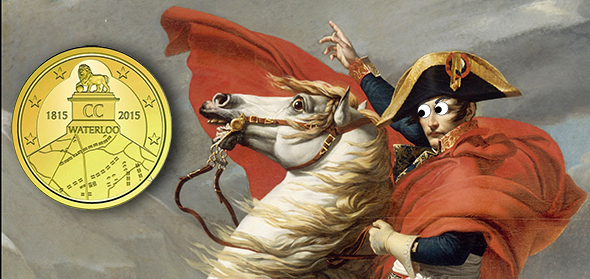
By Charles Morgan and Hubert Walker for CoinWeek….
An epic and bloody battle played out on June 18, 1815, claiming the lives of half a million soldiers. It shaped not only 19th-century European politics and culture but had major repercussions around the world.
Though staggered by defeat, French Emperor Napoleon Bonaparte I was spared from paying the ultimate price, the price paid by countless others for his cruel rampage across Europe. He lived out the rest of his years in exile, never again to reclaim the throne he had twice usurped.
To the victors, as is often the case, went the trappings of power and prestige. The British Empire gained a lasting upper hand over their cross-channel rivals, and the stage was set for the rise of a German State. For Wellington, hero in battle at home and abroad, a succulent beef dish was named in his honor. Prussian general Gebhard Leberecht von Blücher won prestige across the Rhineland. On the dinner table… not so much.
But now, 200 years later–many years since one might naively expect the battle has had any relevance to the daily life of France, the U.K. or anybody else for that matter–a brouhaha over a Belgian 2 euro coin has led to the kind of tit-for-tat that is generally amusing to the American observer and encourages our worst tendencies towards smugness. This after Paris called the Royal Belgian Mint’s pending 2-euro commemorative coin celebrating the Bicentennial of Waterloo “detrimental at a time when euro zone governments are trying to build unity and cooperation under the single currency.”
France’s protests against the Waterloo €2 coin led to its heavily-publicized cancellation.
The 2-euro coin is the highest value circulating coin in the Eurozone. At the time of this writing, the 2-euro coin has an approximate value of $2.25 USD.
While the European Central Bank requires uniformity of euro currency notes and a common reverse on its coinage, individual member states are responsible for the obverse designs of their respective coins–all of which circulate freely across the continent.
An apple wine bar in Frankfurt-Am-Main, for instance, might have in its register euro coins from Greece (has the hoarding started yet?), Latvia, Portugal, and Austria. Similarly, a boulangerie in downtown Marseilles might have in its till euro coins from Spain, Germany, and the Benelux.
Had the Waterloo €2 coin been released, Paris feared, French citizens would have to suffer the indignity of spending money that celebrated French national defeat.
Understandable. But, zut alors!, was this acte de résistance really necessary?
It’s not as if the Belgians were the only country celebrating the fall of Napoleon this year. Britain released, without much fanfare or controversy, a pair of commemorative coins (£5 in gold and silver) and a silver medal adapted from the famous design by Benedetto Pistrucci. Besides, in 2009 a Cook Islands release appeared to support the legacy of the “Corsican Ogre”, depicting him in full color, astride his horse, the dual date commemorating his birth and death.
Such is the way of coins and commemorations in the postmodern era.
Nevertheless, the Belgians relented after French protestations, scrapping the 2-euro coins at a reported cost of 1.5 million euros. An untold number of the purported mintage of 180,000 will wind up in collectors’ hands. The desire to own one will elevate the issue to legendary status. No doubt, some percentage of 2-euro collectors being French, will covet the piece that supposedly slighted L’hexagone.
But in the end, Belgium didn’t allow France the final say. The country will commemorate the bicentennial of Waterloo. This time with a 2.5-euro base metal coin and a 10-euro coin struck in silver.
Talk about a Napoleonic complex.
A Difference with a Distinction
While it might seem strange that France would interfere with the production of a Belgian €2 coin but be powerless to stop coins of higher face value, the explanation is straight-forward.
Coins struck with face values above 2 euros are not legal tender in any country other than the country of issue. Therefore, the French €50 gold Napoleon I coin struck as part of the Monnaie de Paris’ De Clovis à la République 1500 ans d’Histoire de France series is not spendable in other Eurozone countries.
Crisis averted.
Belgium expects to produce 70,000 2.5-euro coins. They will be sold to collectors at a cost of €6 a piece. The 10-euro coins, struck in silver, will cost €40 each.




